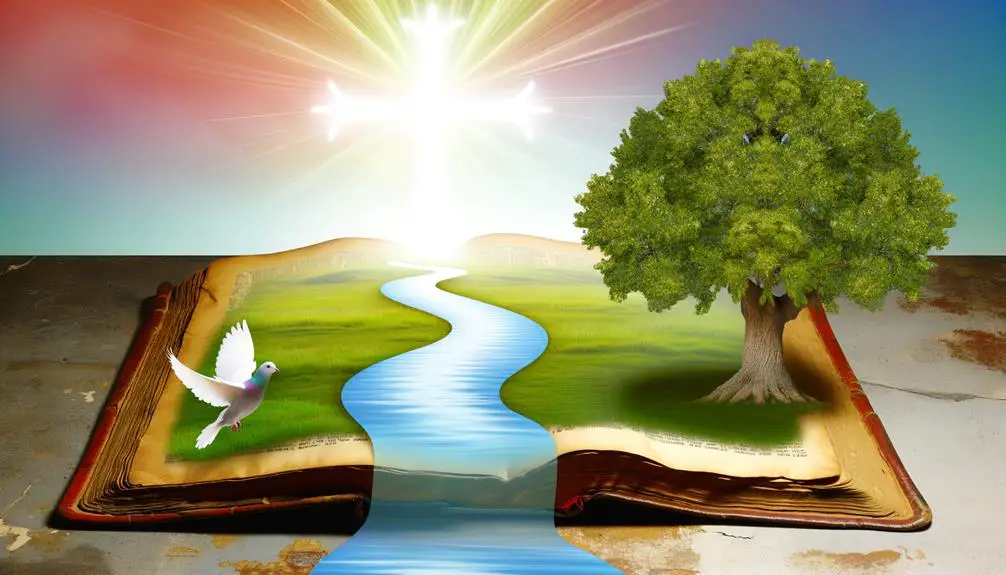Learn how water in the Bible symbolizes life, purification, and divine mysteries, revealing deeper spiritual insights and truths waiting to be explored.

Water in the Bible Represents
Like a river that winds through a barren landscape, bringing life and sustenance, water in the Bible flows with deep symbolic meanings that you might find intriguing.
It's a mirror reflecting various spiritual truths, from purification and cleansing to judgment and destruction. As you explore this topic, you'll see water not just as a physical necessity but as a divine provision, offering insights into transformation, renewal, and even eternal salvation.
The layers of interpretation are vast and varied, inviting you into a richer understanding of biblical narratives. Let's uncover how these ancient texts use water as a metaphor for spiritual truths, hinting at revelations that could enrich your perspective on life and spirituality.
Key Takeaways
- Water symbolizes spiritual purification, cleansing, and rebirth through practices like baptism.
- It embodies divine judgment and redemption, showcasing God's power in narratives like the Flood and Red Sea crossing.
- Water signifies life-giving sustenance and spiritual nourishment, essential for physical survival and spiritual well-being.
- It represents transformation and renewal, with living water offering the promise of eternal salvation.
Purification and Cleansing

In the biblical context, water serves as a powerful symbol for purification and cleansing, illustrating how believers are washed from their sins and impurities. This imagery isn't merely metaphorical but carries profound ritual significance, deeply embedded in the practices and beliefs of the faithful. You'll find that throughout the Scriptures, water isn't just a substance for physical cleaning but a pivotal element in spiritual rituals aimed at purification.
Delving into the ritual significance of water, you encounter the rite of baptism, which stands as a quintessential example of water's purifying symbolism. Baptism, as depicted in the New Testament, isn't just an external act of washing away dirt from the body. It symbolizes the believer's death to sin and rebirth into a life of righteousness. This act of immersion and emergence from water vividly illustrates the transformative journey from sinfulness to purity, encapsulating the essence of spiritual renewal and redemption.
Analyzing the baptism symbolism further, it's clear that the early Christians viewed this sacrament as a pivotal initiation rite. It marked the believer's entry into a new covenant with God, washed clean of past transgressions and reborn into a state of grace. This symbolic cleansing through water underscores the theme of renewal and restoration that permeates biblical teachings on redemption.
In essence, water's role in purification and cleansing in the Bible transcends mere ritualistic practices. It embodies the profound spiritual journey of repentance, purification, and ultimately, redemption, offering believers a tangible symbol of God's purifying grace.
Source of Life

In the biblical narrative, water isn't just a physical necessity; it's a profound symbol for spiritual nourishment and the essence of life.
You'll find that its representation as a source of life is intertwined with themes of renewal, sustenance, and the indispensable nature of spiritual fulfillment.
This symbolism underscores the fundamental belief that just as water is essential for physical survival, so too is spiritual hydration critical for the soul's existence.
Spiritual Nourishment Symbolism
Water, throughout biblical texts, serves as a profound symbol for spiritual nourishment, embodying the essence of life that sustains one's faith and spirit. The narratives are rich with instances where water isn't just a physical necessity but a metaphorical source of rejuvenation and healing. It's entwined with miraculous events and imbued with healing properties, offering a deeper understanding of its spiritual significance.
- Miraculous events: Water turning into wine, showcasing divine intervention and providence.
- Healing properties: The Pool of Bethesda, where water becomes a medium for physical and spiritual restoration.
- Spiritual cleansing: Baptism in water, symbolizing purification and rebirth.
- Living water: Jesus offers the living water, promising eternal life and unending spiritual sustenance.
This symbolism underlines water's role as a vital, life-giving force in the spiritual landscape.
Essential for Existence
Building on its symbolic representation as a source of spiritual nourishment, water also stands as an indispensable element for physical life, underscoring its critical role in both realms. You can't overlook the profound impact water has on existence, especially when considering climate influence and agricultural dependency.
Aspect |
Significance |
|---|---|
Climate Influence |
Dictates rainfall patterns, affecting survival |
Agricultural Dependency |
Ensures food security, enabling civilizations |
These facets highlight water's dual role as both a literal and metaphorical source of life. The Bible's depiction of water mirrors this duality, presenting it as essential for sustaining life on Earth while also symbolizing spiritual rejuvenation. This interplay between the physical and spiritual dimensions of water emphasizes its overarching significance in the biblical narrative, reflecting its necessity in the human experience.
Divine Provision

Throughout biblical narratives, water frequently emerges as a potent symbol of God's provision for His people, underscoring His role as the sustainer of life. This significance is vividly illustrated through miraculous events and the agricultural significance attributed to water, themes deeply interwoven within the fabric of biblical texts. Water, as a divine provision, isn't merely a physical necessity but a spiritual emblem of God's unending care and provision for humanity.
- Miraculous events, such as Moses striking the rock in Exodus and Jesus turning water into wine, highlight God's ability to provide beyond human understanding or effort.
- The agricultural significance of water in a predominantly arid landscape underscores God's role in sustaining life, ensuring the fertility of the land, and by extension, the survival of His people.
- Stories of wells, springs, and rivers becoming sources of life in times of drought or scarcity serve as powerful reminders of God's ability to meet needs in seemingly impossible situations.
- The provision of water for ritual purification rites illustrates God's desire not only for the physical well-being of His people but also for their spiritual cleanliness and readiness to serve Him.
Through these narratives, water symbolizes God's unwavering commitment to provide for His people, both in their physical necessities and spiritual journeys. It serves as a constant reminder of His presence, care, and the promise of sustenance in every aspect of life, inviting believers to trust in His provision.
Transformation and Renewal

Reflecting on the dynamic role of water in biblical narratives, it's evident that beyond mere provision, it also symbolizes profound themes of transformation and renewal. This symbolism is vividly illustrated through baptismal rites and miraculous events, each carrying a deep metaphorical significance that resonates with the core of human experience.
Baptismal rites, for instance, stand as a pinnacle of water's symbolism in the Bible. You're submerged in water, signifying the washing away of the old, sinful self. Emerging from the water represents rebirth, a new creation purified and renewed in spirit. This ritual encapsulates the transformative power of water, not just in a physical sense, but in a deeply spiritual dimension, marking a fundamental change in identity and relationship with the divine.
Miraculous events involving water further underscore this theme of transformation and renewal. Consider Moses striking the rock in the wilderness, from which water flowed to sustain the Israelites. This wasn't just a miraculous provision; it was a sign of renewal, a transformation of despair into hope, reinforcing God's ongoing commitment to transform and renew His people in times of need.
Through these narratives, water becomes a multifaceted symbol, embodying not only life-giving sustenance but also the profound potential for change, purification, and new beginnings. It's a reminder that transformation and renewal are central to the human experience, deeply woven into the fabric of spiritual life and signified through the elemental, yet profound, substance of water.
Judgment and Destruction

You've observed how water symbolizes transformation and renewal, yet it also embodies judgment and destruction within biblical narratives.
The Flood of Noah and the Red Sea crossing serve as pivotal examples where water functions as a divine instrument of judgment against wickedness and oppression.
These events highlight the dual nature of water as both a source of life and an agent of divine retribution.
Flood of Noah
The Flood of Noah stands as a pivotal event in the Bible, symbolizing both judgment and destruction on a scale unprecedented in biblical history. This narrative highlights the ark construction by Noah, an act of obedience amidst a corrupt world, and the gathering of animal pairs, which underscores the preservation of life amidst widespread destruction.
- Ark construction reflects humanity's potential for salvation through faith and obedience.
- Animal pairs entering the ark symbolize the continuity of God's creation despite human failure.
The deluge represents divine displeasure with human wickedness, purging the earth of its corruption. The aftermath portrays a promise of renewal, where water becomes a medium of both judgment and mercy.
This story encapsulates a profound theological reflection on judgment, mercy, and the possibility of new beginnings.
Red Sea Crossing
In biblical symbolism, water's dual role as both destroyer and redeemer becomes vividly apparent during the Red Sea Crossing, a narrative that epitomizes divine judgment against oppression and a path to liberation for the Israelites.
This event isn't merely a tale of escape; it's a masterclass in the interplay between miraculous intervention and military strategy. As you delve deeper, you realize the waters serve as a divine agent executing judgment on the oppressors while simultaneously crafting a route of salvation for the oppressed.
The parting of the Red Sea, therefore, isn't just a spectacular display of power. It's a calculated act, underscoring the strategic use of natural elements to achieve divine ends. This story teaches that liberation often comes through unexpected means, with water as the medium of both destruction and deliverance.
Eternal Salvation

Water, throughout the Bible, symbolizes eternal salvation, offering a profound insight into how this essential element reflects the promise of everlasting life for believers. This symbolism is vividly portrayed in two key concepts: Baptism symbolism and the notion of Living water.
In the act of baptism, water serves as a powerful symbol of purification and renewal, mirroring the transformative journey of the believer towards salvation. This ritual embodies the washing away of sins and the rebirth of the individual into a new life in Christ. It's not merely a physical act but a profound spiritual awakening that aligns believers with the promise of eternal life.
The concept of Living water further deepens this symbolic connection. Jesus, in his discourse, offers 'living water' as a metaphor for the eternal life that He provides to His followers. This living water represents a source of spiritual sustenance that never runs dry, a promise of eternal salvation that quenches the deepest spiritual thirst.
To evoke emotion in the audience, consider the following:
- Imagine the cleansing power of water washing away every stain of sin, offering a fresh start.
- Picture the living water as an unending source of spiritual vitality, sustaining you through life's trials.
- Feel the profound peace that comes with the promise of eternal salvation, a hope that never fades.
- Embrace the sense of belonging and renewal that baptism symbolizes, marking your acceptance into a community of faith.
Analyzing these biblical references, it's clear that water's role transcends its physical properties, embodying the profound promise of eternal salvation for those who believe.
Frequently Asked Questions
How Has the Symbolism of Water Evolved in Christian Liturgy and Practices Outside the Biblical Narrative?
In Christian liturgy and practices, the symbolism of water has deepened beyond its biblical origins. You'll find that baptismal rites and the use of Holy Water have evolved to embody purification, initiation, and protection.
These rituals, steeped in tradition, now serve as tangible connections to divine grace. They've been adapted and enriched over centuries, reflecting a broader theological understanding and the community's spiritual needs, showcasing water's enduring, multifaceted symbolism in Christianity.
What Are the Differences in Water Symbolism Between the Old Testament and the New Testament?
Diving into the depths of your inquiry, you'll find that the symbolism of water shifts from the Old to the New Testament.
In the Old Testament, water often emerges in Creation narratives and Prophetic imagery, symbolizing both life and destruction.
Meanwhile, the New Testament reinterprets these symbols, primarily using water as a metaphor for purification and salvation.
This evolution underscores a broader theological shift, emphasizing redemption and the promise of new life.
Can Water Symbolism in the Bible Be Connected to Water Myths and Symbols in Other Ancient Cultures?
Absolutely, you can find connections between water symbolism in the Bible and water myths in other ancient cultures. These ancient rituals often share common themes, such as purification, transformation, and renewal.
How Do Modern Interpretations of Water Symbolism in the Bible Address Environmental Concerns and Water Conservation?
You might find it fascinating how modern interpretations of water symbolism tackle environmental issues, including water politics and filtration technology. Scholars are digging into these symbols, connecting them to current global challenges.
They're analyzing how ancient texts might inspire sustainable water use and conservation efforts today. It's a unique blend of historical insight and contemporary environmental science, offering fresh perspectives on tackling water scarcity and promoting cleaner, more accessible water for all.
In What Ways Has Water Symbolism in the Bible Influenced Contemporary Art, Literature, and Film?
You'll find that water symbolism from the Bible has deeply influenced contemporary art, literature, and film. It's not just a backdrop; it's a powerful motif that explores themes of purification, chaos, and renewal.
Artists and filmmakers often draw on these biblical symbols to add depth and resonance to their work, weaving in layers of meaning that echo ancient narratives. This use of water symbolism enriches the cultural tapestry, offering new perspectives on timeless themes.
Conclusion
In conclusion, water in the Bible symbolizes a multifaceted spiritual reality. You've seen it as a means of purification and a vital source of life, reflecting God's provision and the transformative power leading to renewal. Despite its association with judgment, water's role in signaling eternal salvation can't be overlooked.
Some may argue this interpretation stretches the symbolism too far, but a deeper, contextual analysis reveals these layers are interwoven throughout biblical narratives, enriching our understanding of divine messages.



Sign up